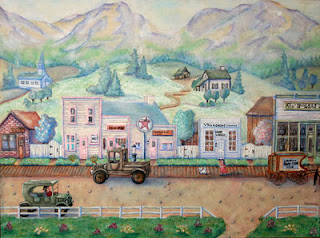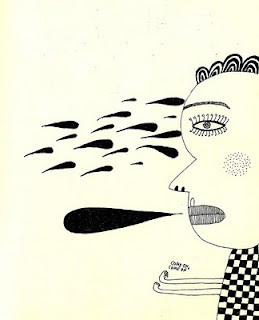Butler Dairy, oil, 1990
These painters strive to quilt the bits and pieces of our history as Americans into a visual tale reflecting the day-to-day pleasures of years past: winter sledding, holiday celebrations, working the soil, Sunday afternoon buggy rides and the companionship of neighbors and friends. American art is unique to us, it tells of our traditions and our heritage.
Potato Valley, oil 1991
Growing up as second generation Colorado Native, the landscape of the Rocky Mountains influenced me to paint my own versions of stories of my people. I call myself a neo-utopian artist rather than Americana painter, as my stories of life were dreams of the "good-old-days", a kind of wish for a safe and perfect world.
Georgetown, watercolor 1992
Of course life was not perfect in Victorian time, or in the early twentieth century, but it also did not boast of nuclear war, gang violence or drug cartels which were are a part of life as we know it today.
Hot Air Balloon Ride at the Circus (Hugo Colorado)watercolor 1994
I played with pastel colors, creative perspective and naive representation telling stories of times and people from an imaginative events/ neo-perfected environment. with both watercolor and oil paint.
Home at Last mixed media 1998 - 2002 (repaint)
The next logical step was to tell a story of a place that only exists in my mind. Thus note the purple dragon and the mermaid.
Howloween at the Dog Drop Inn, aqua oil- 2003
From time to time I am still tempted to complete one of these works, which with all the detail are very time consuming. I always have ideas, and sometimes sketches, and hope to continue to the next sentimental journey into the past, or into my imagination.
It all began for me in 1989 at an Artist of America show in Denver where I saw my first Americana painting by Charles Wysocki. My paintings were bright and full of color texture and pattern, and so are Wysocki's.
I think so similar to Wysocki that I have even made work that is similar to his without realizing that they are of a similar mindset.
Playing School, tempera and ink resist, Kara English 2010
Charmed by a style that is neither purely folk nor primitive,
wysocki's paintings of a simpler time of history are snatched up as quickly as they become available. Most people are familiar with his work as calendars and prints but his paintings sell for much much more.
Now, when faced with the prospect of telling tales with your art work, consider America art, and Charles Wysocki's world as a possible direction of an artist who has told many a tale.













